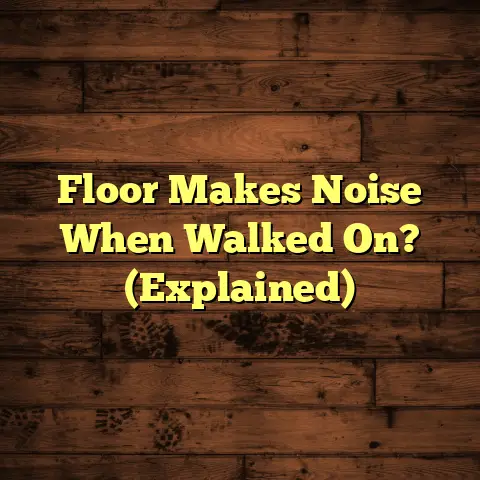Can Uneven Floors Be Fixed? (Explained)
When I think about a cozy home, I envision a space where every room feels inviting and comfortable. I remember visiting a friend’s house a while back. The moment I stepped inside, I could feel the warmth of the wood floors beneath my feet. It was beautiful, but as I walked through, I noticed something off—the floors weren’t perfectly level. It was subtle, but enough to make me wonder: can uneven floors be fixed?
Understanding Uneven Floors
Uneven floors aren’t just an eyesore; they can also affect the overall comfort of your home. Over time, I’ve encountered various situations where floors have dipped, swayed, or even creaked. In my experience, the causes range from settling foundations to moisture issues. Each case requires a different approach to correct the problem.
It’s essential to understand that uneven flooring can also lead to other issues like doors not closing properly, cracks in walls, and even potential safety hazards. Many homeowners might overlook these signs until they become more pronounced, which often leads to more extensive repairs down the line.
Common Causes of Uneven Floors
- Foundation Settlement
One of the most common culprits for uneven floors is foundation settlement. In my early years as a flooring contractor, I worked on a house where the foundation had shifted due to soil erosion. The homeowners had noticed their hardwood floors buckling. Addressing this issue involved consulting with a structural engineer, which can be a crucial step to ensure safety. - Moisture Problems
Another challenge I faced was moisture in the crawl space. I once took on a project in a coastal area where humidity levels were high. The moisture caused the floor joists to rot, leading to noticeable dips in the flooring above. It’s essential to check for proper ventilation and moisture barriers in these situations. - Improper Installation
Sometimes, uneven floors result from poor installation techniques. A few years ago, I had a client who hired a contractor for laminate flooring installation without proper subfloor preparation. When I was brought in to fix it, I found that the subfloor wasn’t level, which contributed to the unevenness of the laminate. - Age of the Home
Older homes often come with their own set of quirks. I’ve worked on many older properties where the natural settling of the house over decades led to uneven surfaces. This is particularly true for homes with wooden framing systems that might have warped or cupped due to age. - Pest Infestation
In one instance, I encountered a situation where termites had caused significant damage to floor joists in a home. The compromised structure led to sagging floors that needed immediate attention. This situation highlighted the importance of regular inspections for pests that can undermine your flooring’s integrity.
Assessing the Situation
Before jumping into solutions, I always recommend doing a thorough assessment. Grab a level and check for any significant dips or rises in your flooring. If you notice more than a quarter of an inch difference over a span of ten feet, it’s time to take action.
Visual Inspection
I like to start with a visual inspection of the flooring and surrounding areas. Look for gaps between the floor and baseboards or cracks in walls that may indicate shifting foundations. Additionally, check for signs of water damage or mold that could signal moisture issues.
Sound Testing
Another method I’ve used involves walking around while listening for any unusual sounds, such as creaks or pops. These sounds can indicate loose floorboards or issues with your subfloor.
Measuring Levels
Using a level tool to measure various points across your floor can give you a clearer picture of how uneven it truly is. Marking these measurements can help when discussing potential solutions with contractors or engineers.
Solutions for Uneven Floors
1. Shimming
One of the simplest methods for leveling floors is shimming. This involves inserting thin pieces of wood or plastic under the flooring to raise it to an even level. I used shimming in a project where an old house had settled unevenly over the years. It was time-consuming but ultimately effective in providing a solid base for new flooring.
- Materials Needed: Shims (wood or plastic), hammer, and level.
- Process: Identify low spots using your level, then carefully insert shims beneath the affected areas until the floor is even.
2. Reinforcing the Subfloor
In some cases, reinforcing the subfloor is necessary. I worked on a home where the plywood subfloor was sagging between the joists. We added blocking between joists for extra support, which helped redistribute weight and reduce movement.
- Materials Needed: Plywood sheets or 2×4 lumber, screws, and possibly additional joists.
- Process: Remove any existing flooring materials carefully, then install new blocking between joists at intervals to provide extra support.
3. Self-Leveling Compound
For larger areas with significant dips, self-leveling compound can be a game-changer. On one occasion, I faced a challenge with a sunken area in a living room that needed new tile flooring. We poured a self-leveling compound over the existing subfloor, creating an even surface for tiling.
- Materials Needed: Self-leveling compound, mixing bucket, trowel, and primer (if required).
- Process: Prepare the subfloor by cleaning it thoroughly and applying primer if needed. Mix and pour the compound according to manufacturer instructions, spreading it evenly across the area.
Cost Considerations
When it comes to fixing uneven floors, costs can vary significantly based on the extent of the problem and chosen solutions. Here’s where FloorTally comes in handy for me. It helps me create accurate cost estimates by pulling local material and labor rates directly into my project plans.
- Shimming: Usually costs between $1 to $3 per square foot.
- Reinforcing Subfloor: Around $2 to $5 per square foot.
- Self-Leveling Compound: This can run anywhere from $3 to $7 per square foot, depending on depth and materials.
Having these estimates helps me explain potential costs to clients transparently, building trust and keeping everyone on the same page.
Challenges Encountered
While fixing uneven floors can be rewarding, it’s not without its challenges. I’ve had projects where unforeseen issues arose after starting work. For example, while reinforcing a subfloor, I discovered mold due to previous moisture problems. This led to additional repairs and delays, which can be frustrating but necessary for long-term results.
Another challenge is managing client expectations regarding timelines and costs. Sometimes what appears to be a minor fix can turn into a larger project once you get into it. Clear communication is vital in these situations.
Tips for Homeowners
If you’re considering tackling uneven floors yourself or hiring someone, here are some tips based on my experiences:
- Do Your Homework: Research different approaches before deciding how to fix your floors.
- Consult Professionals: When in doubt, consult with structural engineers or experienced contractors.
- Check for Moisture: Always assess moisture levels before installing new flooring.
- Use Quality Materials: Cheap materials often lead to more problems down the line.
- Document Everything: Keep records of any work done and materials used; this will help in future repairs or renovations.
- Plan for Disruption: Understand that fixing floors can lead to temporary disruption in your home life; plan accordingly.
Maintenance After Fixing
Once your floors are fixed and looking great again, maintenance is key to preventing future issues. Here are some practical tips:
- Regular Inspections
Check for any signs of unevenness periodically, especially after heavy rains or snowmelt. - Control Humidity Levels
Use dehumidifiers if necessary to keep moisture levels in check. - Proper Ventilation
Ensure crawl spaces and attics are well-ventilated to prevent moisture buildup. - Pest Control
Schedule regular pest inspections to catch any potential infestations early on. - Monitor Changes
Keep an eye on any changes in your home’s structure or flooring; early detection can save you time and money down the line.
Long-Term Solutions
If you’re frequently dealing with uneven floors in your home, it may be worthwhile to consider long-term solutions:
- Foundation Repairs
If structural issues are at play, investing in foundation repairs might be necessary. This could involve underpinning or installing piers beneath the home. - Moisture Barriers
In high-moisture areas, installing moisture barriers can prevent future problems related to humidity and water damage. - Regular Maintenance Plans
Establishing regular maintenance schedules for your home’s foundation and flooring can help catch potential problems early before they escalate into larger issues.
Personal Anecdotes
Over my years as a contractor, I’ve had my share of unique stories when dealing with uneven floors. One memorable project was an old Victorian house that had seen better days—its charm was undeniable but hidden under layers of neglect.
As we began our work, we discovered that past renovations had left us with multiple layers of flooring above an unstable subfloor. This meant we had to strip everything down and start fresh from the ground up—quite literally! While it was daunting at first, this project turned into one of my favorites because we were able to restore it beautifully while teaching the homeowners about proper maintenance along the way.
On another occasion, I encountered a homeowner who was adamant about doing things themselves after watching countless DIY videos online. They were determined to fix their uneven floors without professional help but soon realized that it wasn’t as straightforward as they thought!
After guiding them through their attempts at shimming and leveling compounds (with mixed results), we eventually collaborated on finding a solution together that worked best for their needs—sometimes it takes teamwork and expertise to achieve that perfect finish!
Future Trends in Flooring Solutions
With advancements in technology and materials available today, there are always new trends emerging in flooring solutions:
- Smart Home Technology
Innovations like smart sensors can monitor humidity levels in real-time and alert homeowners when conditions become unfavorable for their flooring. - Sustainable Materials
Many homeowners are moving toward eco-friendly materials that offer both durability and aesthetic appeal without compromising environmental values. - Modular Flooring Systems
Some companies now offer modular systems that allow for easy repair or replacement without needing extensive renovations—these can be particularly helpful in homes prone to shifting foundations.
Final Thoughts
Dealing with uneven floors can feel overwhelming at first, but there are effective ways to tackle these challenges head-on. From shimming to using self-leveling compounds, each method has its place depending on the situation at hand.
Remember that while fixing uneven floors might have its ups and downs—like any renovation project—the end result is often worth it. A leveled floor not only improves aesthetics but also contributes to overall home safety and comfort.
Have you ever faced issues with uneven floors? What solutions did you find most helpful? Let’s chat!





